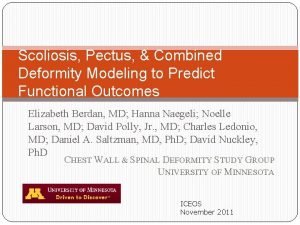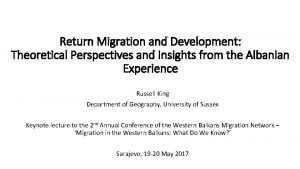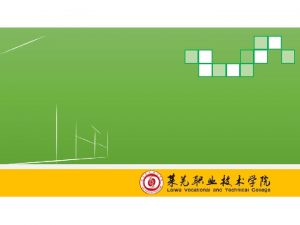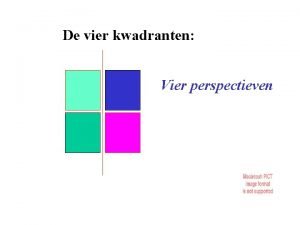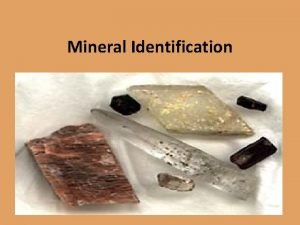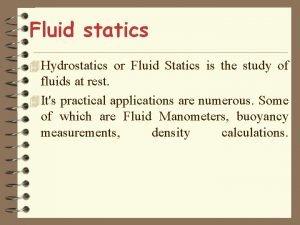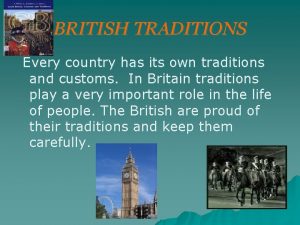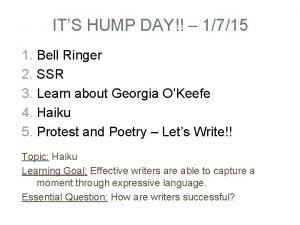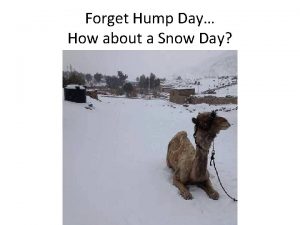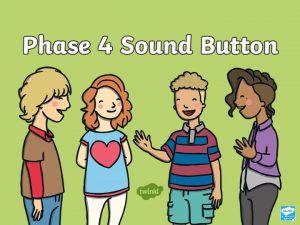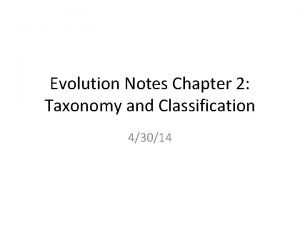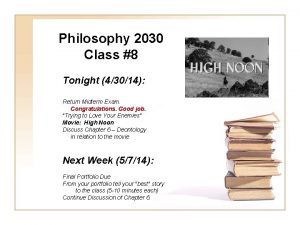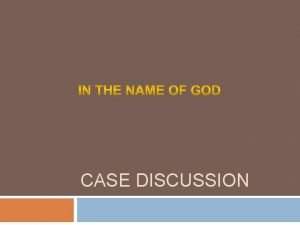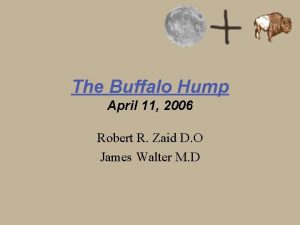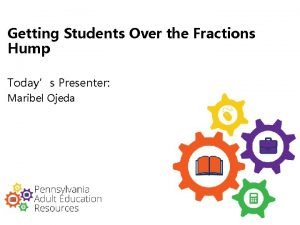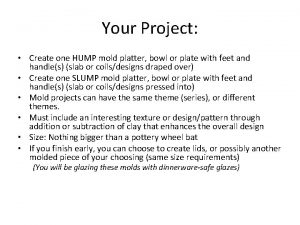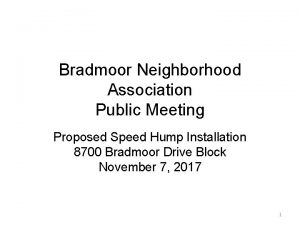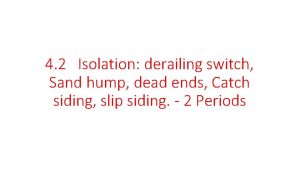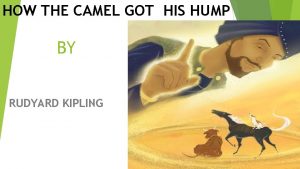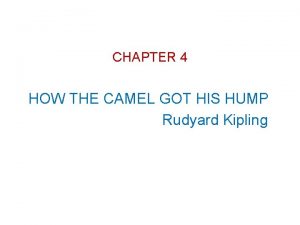ITS HUMP DAY 43014 1 2 3 4






































- Slides: 38

IT’S HUMP DAY! – 4/30/14 1. 2. 3. 4. 5. 6. Bell Ringer Vocabulary Review “Bear Boy” Background Information Read “Bear Boy”/Comprehension Answer Comprehension Questions Visual Literacy Activity Essential Question: How are readers successful? Learning Goal: Effective readers are able to respond to text in order to demonstrate their understanding.

BELL RINGER What is a folktale? Topic Sentence Support 1 Elaboration 1 Support 2 Elaboration 2 Concluding Sentence

VOCABULARY 1. vowed: (v. ) promised solemnly 2. diplomats: (n. ) government representatives who work with other nations 3. summoned: (v. ) called together 4. timid: (adj. ) showing shyness

VOCABULARY 5. initiation: (n. ) process by which one becomes part of a group 6. Neglected: (adj. ) failed to take care of 7. Reproach: (n. ) expression of disapproval

VOCABULARY 8. Conspired: (v. ) planned secretly together 9. Devastated: (v. ) destroyed; completely ruined 10. Dialect: (n. ) a form of language spoken by people in a particular region or group

. “THE BEAR BOY” BY JOSEPH BRUCHAC

BACKGROUND INFORMATION: PUEBLO? WHAT IS A PUEBLO REFERS TO THE VILLAGE-DWELLING NATIVE AMERICANS OF THE SOUTHWESTERN UNITED STATES. THEY ARE MADE OF ADOBE AND CONTAIN HUNDREDS OF ROOMS.

BACKGROUND INFORMATION: WHAT IS A MEDICINE MAN? This is a medicine man from the Navajo tribe of the southwestern U. S. Medicine Men in Native American cultures are believed to have the magical powers of healing. They are also referred to as “shaman. ” Medicine Men understand the connection between the natural world and the spirit world and help to bridge the gap.

BACKGROUND INFORMATION: WHAT IS A CANYON? A canyon is a land form that has a deep valley with steep sides, often with a stream flowing through it.

BACKGROUND INFORMATION: WHAT IS A MESA? A mesa is a land formation, less extensive than a plateau, having steep walls and a relatively flat top and common in arid and semiarid parts of the southwestern U. S. and Mexico.

“THE BEAR BOY” BY JOSEPH BRUCHAC DIRECTIONS Open your book to page 192 1. Read through Questions 1 -11 first. 2. Highlight key words in each question. 3. Then, as you read the story, make notes on your worksheet to remind you where the answer for that question is located. 4. Go back and re-read the questions & circle the correct answers on your answer sheet. Instructor: Stop here! Do not proceed until class is ready to review answers.

QUESTION 1: 1. In paragraph 4, the author introduces the setting and begins to use ______ to create tension in the story. a. motivation b. analysis c. conflict d. connections

QUESTION# 2 2. Based only on Paragraphs 5 and 6 and background knowledge of bears, what can the reader predict will happen to Kuo. Haya? A. The mother bear will defend her cubs by attacking Kuo-Haya. B. Kuo-Haya will run away from this danger. C. The cubs will attack Kuo-Haya. D. The mother bear will play with Kuo-Haya.

QUESTIONS #3 3. What kind of relationship does Kuo-Haya and his father have at the beginning of the selection? A. B. C. D. They have a close relationship and spend a lot of time together. They have a mediocre relationship when the father is around, but the father is gone sometimes. They do not have a close relationship because the father has not taught the son many things. They have a typical, father and son

QUESTIONS # 4 4. What does Kuo-Haya first do when he sees the bear cubs? A. B. C. D. He runs away to safety. He climbs a tree to watch them. He goes to get some other boys to see them, too. He approaches the bears and plays with them.

QUESTIONS # 5 5. How is Kuo-Haya’s life with the bears different than his life in the village? A. In the village, Kuo-Haya is only known for intelligence. B. With the bears, Kuo-Haya learns to be strong. C. In the village, Kuo-Haya is not neglected by people or animals. D. With the bears, Kuo-Haya forgets how to speak and write.

QUESTIONS # 6 6. What advice does the medicine man offer the father? A. He needs to forget Kuo-Haya as his son because his son has another family. B. He needs to let Kuo-Haya return home whenever he is ready to do so. C. He needs to destroy the bears in order to safely bring back Kuo-Haya. D. He needs to bring back Kuo-Haya but in a way that will not harm the bears.

QUESTIONS # 7 7. How does seeing a bee help the father decide how to get his son back? A. It gives the father the idea to use honey as part of his plan to talk to his son. B. The bee leads the father to his son and the bears. C. The father can use the beehive to distract the bears and get his son back. D. The father will provoke the bees to swarm and attack the bears.

QUESTIONS # 8 8. Based on the characteristics of “Bear Boy, ” what genre is it? A. B. C. D. Autobiography Folk tale Essay Myth

QUESTION # 9 9. Which of the following best states theme of “Bear Boy? ” A. Nature will always conquer humankind. B. Friends in nature are greater than family. C. Parents have a responsibility to love and to teach their children. D. Children have a responsibility to listen to their parents at all times. Why is that your answer? Explain using details from the story.

QUESTION #10 10. Which of the following events in “Bear Boy” demonstrates the Kuo-Haya is timid? A. Kuo-Haya reaches the age when he will be initiated into manhood. B. Kuo-Haya learns from his father how to be a great runner. C. Kuo-Haya looks down and slips away when other boys wrestle. D. Kuo-Haya walks into the bear’s cave when his father calls him.

QUESTION # 11 11. The resolution of “The Bear Boy” occurs when A. The mother bear defends Kuo-Haya and outwits Kuo-Haya’s father B. Kuo-Haya returns to the village and shows he is no longer timid C. Kuo-Haya’s father promises that he will always be friends with the bears. D. Kuo-Haya follows the bear tracks and finds happiness with the bears.

QUESTIONS/ANSWERS TO # 1 In Paragraph # 4, the author introduces the setting and begins to present _____ to create tension in the story. A. Motivation B. Analysis C. Conflict * D. Connections *C The author makes the reader understand people’s fear of bears by saying that anyone who follows in footprints may be killed. Also, Kuo-Haya is in terrible danger because his father has not warned him. 1.

QUESTIONS/ANSWERS # 2 2. Based only on Paragraphs 5 and 6 and background knowledge of bears, what can the reader predict will happen to Kuo-Haya? A. The mother bear will defend her cubs by attacking Kuo-Haya. B. Kuo-Haya will run away from this danger. C. The cubs will attack Kuo-Haya. D. The mother bear will play with Kuo-Haya. * A. If the reader only focuses on the wording in these paragraph, it is obvious the other answer choices can be eliminated. “. . . A shadow came over them. Kuo-Haya looked up and saw the mother bear

QUESTIONS/ANSWERS # 3 3. What kind of relationship does Kuo-Haya and his father have at the beginning of the selection? A. B. C. D. They have a close relationship and spend a lot of time together. They have a mediocre relationship when the father is around, but the father is gone sometimes. * They do not have a close relationship because the father has not taught the son many things. They have a typical, father and son relationship according to Navajo tradition. *C. Kuo-Haya’s father has neglected him. As a result, Kuo. Haya is timid and shy around other boys his age and spends time alone.

QUESTIONS/ANSWERS # 4 4. What does Kuo-Haya first do when he sees the bear cubs? A. B. C. D. He runs away to safety. He climbs a tree to watch them. He goes to get some other boys to see them, too. * He approaches the bears and plays with them. *D. The answer to this can be found and

QUESTIONS/ANSWERS # 5 5. How is Kuo-Haya’s life with the bears different than his life in the village? A. In the village, Kuo-Haya is only known for intelligence. B. With the bears, Kuo-Haya learns to be strong. C. In the village, Kuo-Haya is not neglected by people or animals. D. With the bears, Kuo-Haya forgets how to speak and write. *B. The mother bear encourages Kuo-Haya, and he feels like he belongs with the bears. In the village, he feels like an outsider.

QUESTIONS/ANSWERS # 6 6. What advice does the medicine man offer the father? A. He needs to forget Kuo-Haya as his son because his son has another family. B. He needs to let Kuo-Haya return home whenever he is ready to do so. C. He needs to destroy the bears in order to safely bring back Kuo-Haya. D. * He needs to bring back Kuo-Haya but in a way that will not harm the bears. *D. The reader should be able to recall this answer from the story or go back and reread

QUESTIONS/ANSWERS # 7 7. How does seeing a bee help the father decide how to get his son back? A. * It gives the father the idea to use honey as part of his plan to talk to his son. B. The bee leads the father to his son and the bears. C. The father can use the beehive to distract the bears and get his son back. D. The father will provoke the bees to swarm and attack the bears. *A The answer can be recalled after reading, or the reader can go back and double-check if unsure.

QUESTIONS/ANSWERS # 8 8. Based on the characteristics of “Bear Boy, ” what genre is it? A. B. C. D. Autobiography * Folk tale Essay Myth * B. The reader may use the process of elimination. All other choices are obviously incorrect. “Bear Boy” is a Navajo legend and is also considered a folktale.

QUESTIONS/ANSWERS # 9 9. Which of the following best states theme of “Bear Boy? ” A. Nature will always conquer humankind. B. Friends in nature are greater than family. C. * Parents have a responsibility to love and to teach their children. D. Children have a responsibility to listen to their parents at all times. *C The other answers are not relevant to the overall message of the story. Children of any culture learn how to be successful members of society from their parents.

QUESTIONS/ANSWERS #10 10. Which of the following events in “Bear Boy” demonstrates the Kuo-Haya is timid? A. Kuo-Haya reaches the age when he will be initiated into manhood. B. Kuo-Haya learns from his father how to be a great runner. C. Kuo-Haya looks down and slips away when other boys wrestle. D. Kuo-Haya walks into the bear’s cave when his father calls him. * C These actions show that Kuo-Maya lacks the confidence that other boys his age have.

QUESTION/ANSWERS # 11 11. The resolution of “The Bear Boy” occurs when A. The mother bear defends Kuo-Haya and outwits Kuo-Haya’s father B. Kuo-Haya returns to the village and shows he is no longer timid C. Kuo-Haya’s father promises that he will always be friends with the bears. D. Kuo-Haya follows the bear tracks and finds happiness with the bears. *B The resolution of a story always shows how the conflict is resolved at the end. Here, Kuo. Haya’s life has changed by the events in the

GROUP DISCUSSION (GROUPS OF 3): *What are three forms of revolt shown by the characters? *Each group member will draw one of the three scenes that show revolution. *Be prepared to explain what type of revolution your scene is and why.

PAINTING:

LOOK AT THE PAINTING THREE TIMES: What do you notice in a “first draft” reading of the painting? What do you notice in a “second draft” reading of the painting? What do you notice in a “third draft” reading of the painting?

INTERPRETATION : What claim do you think this painting is making? Support your answer.

REFLECTION: How is visual literacy similar to text analysis?
 Happy hump day images
Happy hump day images Day 1 day 2 day 3 day 4
Day 1 day 2 day 3 day 4 Abnormal vq scan images
Abnormal vq scan images Hampton hump sign คือ
Hampton hump sign คือ Chartblocks headquarters
Chartblocks headquarters Rib hump scoliosis
Rib hump scoliosis Migration hump
Migration hump My hat is old my teeth are gold
My hat is old my teeth are gold Day 1 day 2 day 817
Day 1 day 2 day 817 If its square its a sonnet
If its square its a sonnet The emigree poem analysis
The emigree poem analysis Its halloween its halloween the moon is full and bright
Its halloween its halloween the moon is full and bright When a train increases its velocity, its momentum
When a train increases its velocity, its momentum Its not easy but its worth it
Its not easy but its worth it Sunny cloudy windy rainy
Sunny cloudy windy rainy Seed germination conclusion
Seed germination conclusion Oceans apart day after
Oceans apart day after Day one day one noodle ss2
Day one day one noodle ss2 What time in the morning is it romeo and juliet
What time in the morning is it romeo and juliet Seeds vs spores
Seeds vs spores Day to day maintenance
Day to day maintenance Afc futsal coaching course level 1
Afc futsal coaching course level 1 Growing day by day
Growing day by day I live for jesus day after day
I live for jesus day after day As your room gets messier day by day, entropy is
As your room gets messier day by day, entropy is Seed germination inhibitors examples
Seed germination inhibitors examples Family portal schoolmax
Family portal schoolmax Dying he saved me buried he carried
Dying he saved me buried he carried I don't know tomorrow
I don't know tomorrow Liu xiang
Liu xiang Two animals whose ears are not visible
Two animals whose ears are not visible Its learning kwadrant
Its learning kwadrant The way a mineral reflects light from its surface
The way a mineral reflects light from its surface The attacking firm goes head-to-head with its competitor.
The attacking firm goes head-to-head with its competitor. Bernoulli's theorem and its application
Bernoulli's theorem and its application British traditions and customs
British traditions and customs Money market conclusion
Money market conclusion Ndsu help desk
Ndsu help desk Necrosis and its types
Necrosis and its types





